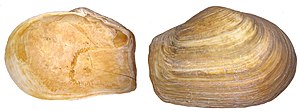Trimmed clam
| Trimmed clam | ||||||||||||
|---|---|---|---|---|---|---|---|---|---|---|---|---|

Trimmed clam ( Mya truncata (Lamarck, 1818)), right shell valve, left inside view |
||||||||||||
| Systematics | ||||||||||||
|
||||||||||||
| Scientific name | ||||||||||||
| Mya truncata | ||||||||||||
| ( Linnaeus , 1758) |
The truncated clam ( Mya truncata ) is a type of mussel from the order of the Myida . Their main distribution area are the arctic waters.
features
The slightly unevenly hinged housing of the truncated clam is elongated-egg-shaped with an almost straight cut off rear end. In contrast, the front end is well rounded. The ventral margin is almost straight. It becomes almost 8 cm long and gapes at the rear end. The approximately orthogyrene vertebrae sit behind the center line (based on the length of the case). The ligament is located inside and outside. To fix the ligament inside, a spoon-shaped appendage ( ligament spoon , chondrophor ) has been developed in the left valve below the vertebra , which has its counterpart in a pit (resilifer) on the right valve below the vertebra. Otherwise no teeth are developed on the lock edge. The right flap is slightly larger and slightly more arched than the left flap. The siphons can be extended to double the length of the housing; but they can also be completely withdrawn into the housing. The mantle bay is deep and wide.
The whitish skin is firm. The surface is covered with concentric growth strips. Occasionally there are also fine radial lines. The permanent organic periostracum is yellowish to dark brown. The inner edge of the case is smooth.
Geographical distribution, habitat and way of life
The range of the species is mainly limited to the arctic waters of the North Atlantic and North Pacific. In the south it occurs as far as the Biscay and the North Sea (including the western Baltic Sea). In the North and Baltic Seas, it is a relatively rare species that has a maximum population density of 1 individual per m 2 . In contrast, population densities of up to 100 individuals per m 2 occur in arctic waters . In the Wadden Sea of the southern North Sea, the truncated clam occurs together with the sand clam ( Mya arenaria ) in the tidal range. However, in contrast to the sand gape mussel, it goes down to a depth of 70 m. In the Baltic Sea it lives at a depth of about 10 to 30 m. The animals live buried in the sandy-silty sediment (up to about 15 cm). It is a distinct form of cold water, which also tolerates the slightly higher temperatures of Biscay, the North Sea and the Baltic Sea. However, it spawns in these areas in winter, at water temperatures such as. B. in Greenland in summer. In some years the reproductive cycle fails completely. This could be due to the increased water temperatures in the North Sea during the winter months in recent decades. She is up to 8 years old. The mussel is the main food of the walrus ( Odobenus rosmarus ).
Taxonomy
The taxon was established by Carl von Linné in 1758. It is the type species of the genus Mya Linnaeus, 1758.
supporting documents
literature
- Guido Poppe and Yoshihiro Goto: European Seashells Volume 2 (Scaphopoda, Bivalvia, Cephalopoda) . 221 pp., Verlag Christa Hemmen, Wiesbaden 1993 (2000 unc. Reprint) ISBN 3925919104
- Rainer Willmann: Mussels of the North and Baltic Seas. 310 pp., Neumann-Neudamm, Melsungen 1989, ISBN 3-7888-0555-2
On-line
Individual evidence
- ^ Teresa Amaro, Gerard Duineveld, Paul Tyler: Does Mya truncata reproduce at its southern distribution limit? Preliminary information. Journal of Shellfish Research, 24: 24-28, New Orleans, 2005 ISSN 0730-8000 (pp. 25ff.)
- ^ Carl von Linné: Systema naturae per regna tria naturae, secundum classes, ordines, genera, species, cum characteribus, differentiis, synonymis, locis. Tomus I. Editio decima, reformata. Pp. 1-824, Holmia / Stockholm, Salvius, 1758. Online at www.biodiversitylibrary.org (p. 670).
- ↑ MolluscaBase: Mya truncata (Linnaeus, 1758)

